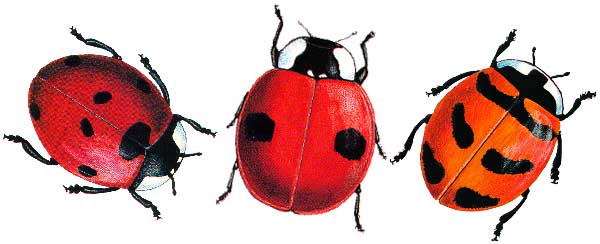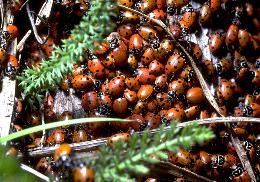|
HOME |
|
|
HOME |
|
Ladybirds are small, oval-shaped winged insects. These shiny insects are usually red with black spots or black with red spots on the wing covers. The number of spots identifies the type of ladybird. Most ladybirds are less 4-8 mm long. As ladybirds age, the spots fade.

There are about 5,000 different species of ladybirds throughout the world. A common species is the two-spotted ladybug (pictured in the middle above); it is orange-red with two black spots.
These tiny predators (Genus Coccinellidae) are helpful in gardens because they eat many garden pests (like mealy bugs and aphids).

They are most often seen in summer. Although many ladybird beetles are warningly coloured (black and red, black and yellow), they are harmless to humans. This bright colouring is to warn their predators (mainly birds) that they are extremely bad tasting.
Both the larvae and adults of ladybird beetles feed on soft-bodied insects, mainly aphids and scale insects. Thus, ladybird beetles can be found on plants infested with these sap-sucking pests. Look for all of them in gardens, greenhouses, fields, and meadows.
Ladybird beetles overwinter as adults, often in large swarms. Eggs are laid in the spring, and larvae appear shortly thereafter. Larvae are easy to recognize by their "alligator-like" appearance...they are fat and black, and may be banded with yellow or red. Often, they are covered with numerous spines, giving them a rather threatening appearance.
When they are ready to pupate, they attach themselves by the posterior end to a branch or leaf. Adults appear a few days later, and are active (eating and mating) well into the autumn, as long as the weather is warm and mild. Both larvae and adults of ladybird beetles feed on insect pests such as aphids and scale, and so are very helpful insects.